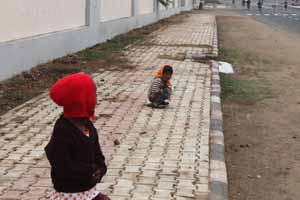A cabinet minister from Gujarat a couple of days ago tweeted that “It is wonderful to see the nation getting ready for Vibrant Gujarat.” As the Mahatma Gandhi convention centre — the venue for both Vibrant Gujarat Global Investors’ Summit and the Pravasi Bharatiya Diwas — gets decked up to receive “two million” visitors from across the globe, just 100 metres from the venue is a group of 2,000-odd slum-dwellers who are struggling for toilets.
The Sector-13 slums located at a stone’s throw distance from the venue is one of the largest slums in the state capital Gandhinagar. Hidden by a wall recently constructed, open defecation is a bane for these residents who have been struggling to attract the attention of the state government.
“There are about 500 families in this locality. Most of us are forced to defecate in the open. Our women and children have to wait for nightfall to use the sides of the road that lead to the Mahatma Mandir or take cover of the foliage that is behind the slums and the railway station behind us,” says 34-year-old Vinu Kavithiya, who runs a make-shift shop inside the slum.
Interestingly, the slum-dwellers have 24 X 7 electricity connection, solar street-lights, some of them have DTH antennas on top of their hutments, some own bikes and rickshaws. “Toilets, adequate drinking water and proper homes are something that we do not have,” says Bharat Vaghri, who sells second-hand blankets on his cycle rickshaw for a living.
“The state government has been organising events at Mahatma Mandir, where people dressed in black suits come in cars and buses. But no body bothers about the group of people living so near. Earlier, during such mega events, officials from the state government would put up huge curtains on the road that would help hide the slums from public view. Couple of years back, they built a permanent wall,” says Raju Jhadhav, who claimed to have worked as a private security guard at the Mahatma Mandir when the complex was taking shape.
Ironically, the Mahatma Mandir which will see a massive inflow of visitors between January 7-13, 2015— has 15 small and big toilet blocks, including those for VIP visitors, that are spread over a total area of 12,000 square feet and remain unused for major part of the year.
The residents claim that most of them were moved to Sector-13 about 35 years ago when slums were cleared near the Akshardham temple in Gandhinagar. “Most of us have ration cards and we are registered voters. The only time the we are remembered is during elections,” said Mayur Rana, who drives an autorickshaw for a living.
Pointing to the on-going work at the salt dome museum and Mahatma Mandir — located opposite each other across the ‘KH’ road — one of the slum-dwellers Laxman Bhogaviya says, “If the state government had spent even a pinch of what is being spent on such super-structures, people like us could have had better sanitation.” The ‘KH’ road is currently being expanded and road-side signages are been given a fresh coat of paint before the event that is expected to begin in January.
The residents near the Vibrant Gujarat venue are struggling for toilets at a time when the Gujarat government is on a massive overdrive to construct public toilets across the state and has targetted to make Gujarat “open defecation-free” in the next two years.
When quizzed as to why there were no toilets present in this slum in Sector-13, the Gandhinagar collector Ravi Shanakar said, “We will be shifting the entire slum. We have already readied 800 houses where these slum-dwellers will be shifted very soon. The verification of the allottees have already been done and we are awaiting the state government’s approval.”
In one of her recent addresses at a public forum in November 2014, Chief Minister Anandiben Patel spoke that the state government has set a target of 2015 for providing every household in urban Gujarat with a toilet. According to her, the state government had already constructed 1.25 lakh toilets in urban areas in the last one year. “In addition to that, we have approved the construction of 3 lakh more toilets,” she had said.

